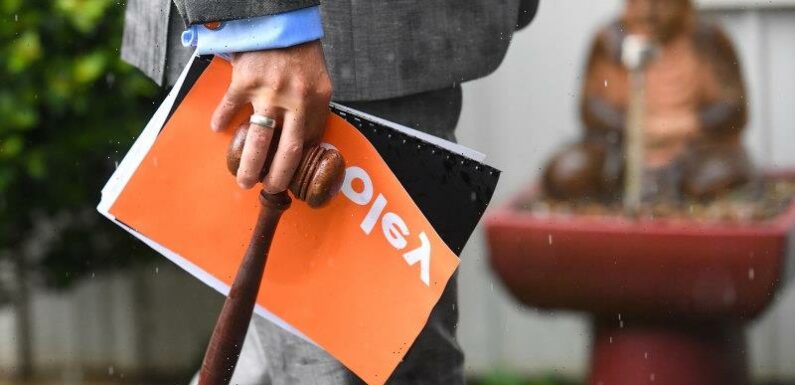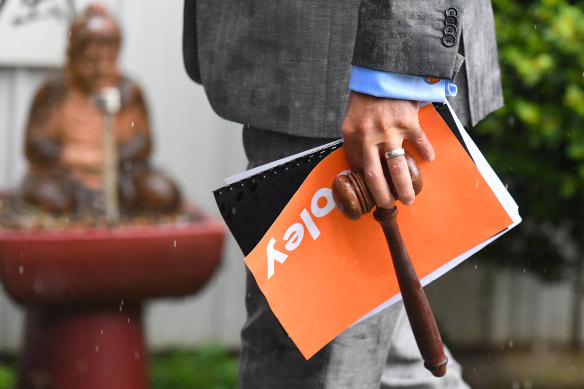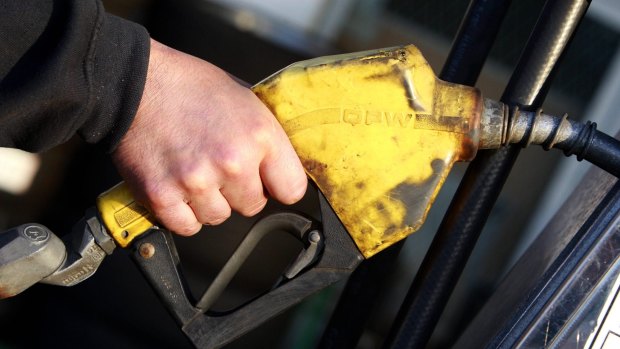
A surprise slowdown in inflation and further falls in property values that have wiped $53,000 from the average dwelling could force the Reserve Bank into reassessing its plans to drive up interest rates next year.
In a sign the RBA’s aggressive tightening of monetary policy continues to weigh on the nation’s property market, CoreLogic on Thursday reported national property values dropped by another 1 per cent through November.
House values have fallen for a seventh consecutive month. Since their peak, the average dwelling value is down $53,400.Credit:Peter Rae
National average dwelling values are now down by 7 per cent or about $53,400 from their peak in April.
The biggest hit in percentage and absolute value terms has been Sydney where the median house value fell another 1.5 per cent last month. The median house value in Sydney has fallen to $1.243 million, a drop of $170,000 or 11.9 per cent since its peak at the start of the year.
In Melbourne, house values fell by one per cent in November to be down 8.1 per cent so far through 2022. The city’s median house value is now $915,000, a drop of almost $90,000 since its COVID peak recorded at the start of the year.
CoreLogic research director Tim Lawless said the drop in November was the seventh consecutive monthly fall in values but the 1 per cent decline was the smallest since June.
He said it appeared the pace of decline was abating, driven by the Sydney and Melbourne markets.
“There is still the possibility that the pace of declines could re-accelerate, especially if the current rate hiking cycle persists longer than expected,” he said.
“Next year will be a particular test of serviceability and housing market stability, as the record-low fixed rate terms secured in 2021 start to expire.”
Lawless said of all the capital city markets, there was a chance Melbourne’s median value could slip to its pre-COVID level by March next year if prices there continued to fall by 0.8 per cent a month. All other capitals are expected to retain most of the run-up in values experienced during the pandemic.
Much hinges on the actions of the Reserve Bank board, which has taken the official cash rate from 0.1 per cent in May to 2.85 per cent. Markets and economists are expecting another quarter percentage point lift in rates at the bank’s meeting next week.
But the Australian Bureau of Statistics’ new monthly measure of inflation, released on Wednesday, showed possible signs of a slowdown in price pressures.
The annual rate of inflation slipped to 6.9 per cent in October from 7.3 per cent in September. Economists had been expecting a lift in the inflation rate, which the Reserve Bank is expecting to hit 8 per cent by December.
Part of the fall was due to changes in the way households are spending that affect how the inflation rate is compiled. But there were also large falls in the prices of fruit and vegetables, which slipped by 6.3 per cent in October.
Prices for holiday travel and accommodation fell by 6.4 per cent in the month.
Transport costs, driven up by higher petrol prices, lifted by 7 per cent in October.Credit:James Davies
But there continues to be inflation pressures. Transport costs, which are dominated by automotive fuel, jumped by 7 per cent in the month while clothing and footwear prices lifted by 3 per cent.
There was also a 0.6 per cent lift in rents and experts are forecasting they will continue lifting due to the nation’s tight rental market.
The monthly inflation figures do not include many items that will feature as part of the bureau’s traditional quarterly inflation report, such as power prices which are expected to drive up prices in the December quarter.
Treasurer Jim Chalmers noted there had been a slight easing in inflation pressures in October but warned there were further price pressures ahead.
“The October result is yet to fully reflect the impact of the floods on grocery prices or the hit to energy bills caused by the war in Europe and the Coalition’s decade of policy chaos,” he said.
Separate data from the bureau showed a larger-than-expected 6 per cent fall in building approvals through October. Approvals for private homes dropped 2.2 per cent to be down by 11.3 per cent over the past year.
BetaShares chief economist David Bassanese said the lower-than-expected result would give the RBA pause for thought.
“At face value, this strengthens the case for the RBA to consider a potential pause in its rate hike campaign after next week’s likely eighth rate hike this year,” he said.
“At a time when home loan affordability is already near its worst levels in 30 years, wage growth and inflation expectations remain contained, and the US economy faces a growing risk of recession, it suggests the RBA can afford to tread a little more cautiously in raising rates in the new year.”
Cut through the noise of federal politics with news, views and expert analysis from Jacqueline Maley. Subscribers can sign up to our weekly Inside Politics newsletter here.
Most Viewed in Politics
From our partners
Source: Read Full Article

